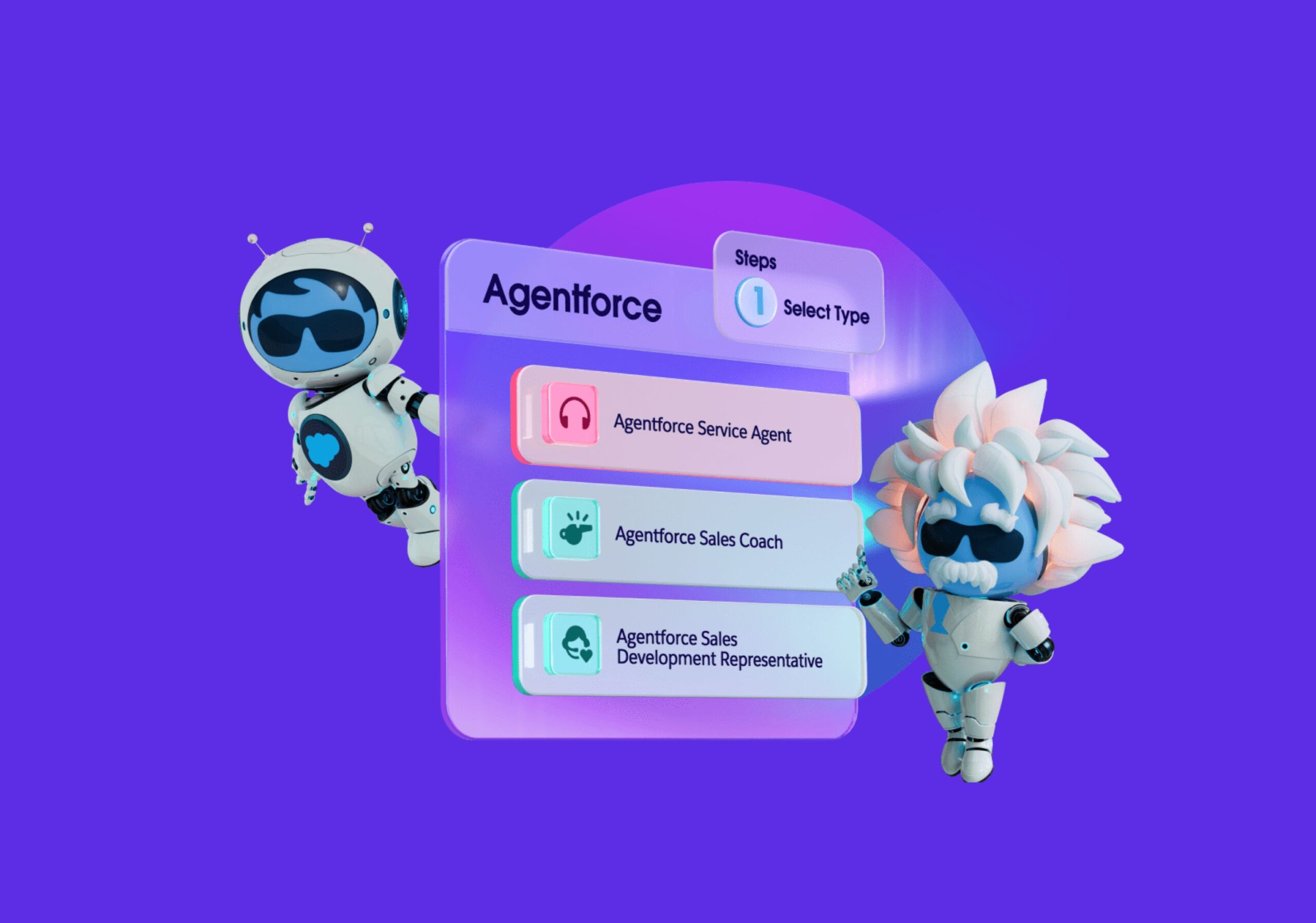Agentforce. Agentforce. Agentforce.
Unless you’ve been living under a rock, it’s almost impossible to miss the hype surrounding Salesforce’s new AI agent system.
And this time, the hype machine’s not wrong, Agentforce IS an exciting feature.
Why? Because now, every business using Salesforce CRM has the opportunity to use built-in AI magic to handle complex tasks more flexibly than ever before.
A smart, flexible digital co-worker
This ain’t your standard chatbot, responding with pre-prepared text and direct answers to requests.
Unlike the limiting ‘yes/no’ logic of traditional, rule-based automations, Agentforce is capable of understanding non-standard instructions (like a messy client email) — and then making updates to data across your systems.
Imagine a customer emails to request a change in the delivery date for a new dog bed. With the right training, Agentforce could:
- 📅 look up the customer’s current delivery date,
- 📦🚚 suggest alternative options based on live stock and driver availability,
- ✅📨 confirm changes with the customer, and;
- 🔁🗂️ change the date and details across all your connected systems.
And, critically, Snuffles gets his comfy new bed ASAP, without a human needing to lift a finger. Which leaves your customer service team space to focus on more critical issues, like resolving service failures, and creating those human moments that leave customers truly happy.
But, are we getting excited about the right things?
As with all shiny new Salesforce features, it’s inevitable that some people are getting excited about Agentforce for the wrong reasons.
And with decades of automation experience, we’ve got a nose for spotting the real opportunities amongst the too-good-to-be-true ones.
So here’s our steer on why you shouldn’t be excited about Agentforce, countered with real tips and pointers to get you pumped about applying it to your workflow.
1. If you’re excited by the idea of a ‘ChatGPT’ that instantly solves all your customer problems — sorry.
Yes, generative AI makes life easier. But public-facing models like ChatGPT are trained to sound smart, not to be accurate.
If you’ve played around with ChatGPT for more than five minutes, you’ll have already encountered this classic response:
✅ Confident tone
🤪 Completely wrong answer
For example, we asked it what Agentforce was and it responded with:
“Agentforce is not an official Salesforce product… It’s often used informally for insurance broker platforms.”
Not even close.
When you use ChatGPT, this isn’t a huge problem. You’ve (hopefully) got the context to say “hmm, that doesn’t sound right.” But when a customer is talking to an AI agent, they have no way to check what’s true or what’s an AI hallucination.
And when that AI agent has the power to update your systems, send emails autonomously and change customer records—you can’t afford mistakes.
Agentforce needs the right onboarding
Unlike generative AI, Agentforce doesn’t run out of the box. While it is backed by Salesforce, who have put a fair bit of thought into keeping you and your data safe, the model needs careful training and tight constraints to avoid making too many mistakes. Here are our tips to set Agentforce up for success:
- 🧹🧱 Get your Salesforce data clean and structured. Leave no room for Agentforce to get the wrong idea.
- 🎯📌 Start small. One job, one function — get that right and expand its guardrails from there.
- 🔒📊 Point only at the data it needs. Just what’s required, nothing more.
- 📏🧭 Define tight parameters. Provide clear instructions on the decisions it can make, and where it stops.
- 🚩🙋♂️ Train it to escalate to a human when unsure. Have Agentforce treat any uncertainty as a red flag, not an opportunity to make up a better solution.
Think of setting up Agentforce like onboarding a new trainee. You wouldn’t expect them to magically ‘just work’ on Day 1. You’d show them the ropes, give them clear instructions and check their work.
And over time, you’d expand their role — but only after they’ve mastered their first assignment.
2. If you’re excited to throw it into every function of your business ASAP, calm down.
Remember that new trainee analogy? Now imagine you had ten new starters arrive on the same day. One for sales. One for marketing, finance, customer care, ops… the whole squad.
For months, you’d expect every department to be in supervision mode — answering questions, correcting mistakes, re-explaining the same processes in slightly different ways.
And you’d expect that more complex functions, requiring more nuance, variability, or judgement calls, would see a higher risk of errors and more retraining time. Agentforce is no different.
Agentforce needs the right role
To maximise your return on investment (and reduce the time spent on setup and supervision), make sure you deploy Agentforce in the right first role—where the work is simple and the payoff is clear.
To define the perfect Agentforce ‘starter job’ in your business, look for functions where:
- ✅ Clean, structured data already lives in Salesforce
- ✅ Clear, repeatable processes are in place
- ✅ high-volume, low-variation workflow, with lots of similar enquiries
- ✅ The impact of a mistake is low-stakes and recoverable
- ✅ You’re already tracking KPIs, so you can measure ROI
- ✅ There’s a clear human escalation pathway if something’s unclear
In our opinion, an easy first role is customer service triage. Use Agentforce to handle the initial contact point, categorise the enquiry, respond automatically where it meets its parameters (like the fridge example above), or escalate it on to the right human.
3. If you’re excited about reducing your customer service headcount – stop that.
Firstly: Uncool, man.
Secondly: Agentforce is not a tool for doing “the same with less”. It’s a tool for doing ‘more with the same’.
It’s important not to approach Agentforce as a replacement, but a buffer to stop your team wasting time on repetitive tasks you can train an AI to do:
- 🧾Sending receipts
- 🔄📦Checking and changing orders
- 📇✏️Updating contact details
- 📝📥Logging standard requests
- 🔍📨Sifting through basic enquiries
- 🚨📣Escalating critical problems
This finally frees your team to focus their time on the complex or relationship-building tasks only they have the experience, context and human nuance to do.
When you view Agentforce this way, you see the real benefit. Your people will do more of the work that ultimately grows your business, while Agentforce handles more of the bulk, repetitive work that maintains it.
Agentforce is exciting for all the right reasons
In our opinion, Agentforce has the potential to be much more than the standard ‘shiny new’ Salesforce feature.
Implemented right, it’s a new type of digital teammate.
But as with any new teammate, a successful ‘onboarding’ matters. You need to start Agentforce on the right job, train it well, supervise closely and be ready to catch new-starter mistakes.
With your data in its hands, adding Agentforce to your team comes with a lot of responsibility.
Agentforce works best with the right partner
So, our final Agentforce tip is to recommend working with a Salesforce implementation expert (like us) to get it up and running more quickly, more effectively, and without the risk to your time, data, or customer relationships.
With years of experience in automation, we can handle setup and training so you can unlock Agentforce’s full potential, free up your team from mundane tasks—by giving them the AI support they’ve always needed.
That’s the kind of ✨shiny new feature✨ we can get excited about.
🤩

